Numerical Simulation Study of Basement Water Discharge Pressure Relief Method under Rainstorm Conditions
Abstract
:1. Introduction
2. Materials and Methods
2.1. Water Discharge Pressure Relief Method
2.2. Unsaturated Seepage Theory
2.3. Project Overview and Numerical Simulation Calculation Model
2.4. Rainfall Intensity and Boundary Conditions
3. Numerical Simulation Results and Analysis
3.1. Influence of Drainage Hole Parameters
3.2. Influence of Soil Parameters
3.3. Analysis of Seepage and Basement Stability
4. Conclusions
- In this article, Flac3d 6.0 software is used to conduct a numerical simulation study on the basement under rainstorm conditions based on the water discharge pressure relief method. It has been observed that the arrangement of drainage holes can impede the rapid rise of water buoyancy in the basement floor, thereby ensuring the structural stability of the basement under rainstorm conditions.
- The anti-floating effect of the water discharge pressure relief method under rainstorm conditions is enhanced as the height and spacing of the drainage holes decrease, while it is diminished as the aperture of the drainage hole decreases. The height and spacing of the drainage holes are the main factors affecting the anti-floating effect. Therefore, in order to ensure the safety and stability of the basement during adverse weather conditions like rainstorms, it is crucial to prioritize the reduction in the height and spacing of the drainage holes when designing the basement’s anti-floating system. The recommended spacing for the drainage holes is between 2 m and 3 m. The height of the drainage holes should range from 1 m to 1.5 m. Additionally, the aperture of the drainage holes should not be smaller than 100 mm.
- Under rainstorm conditions, the water head of the basement floor decreases as the permeability coefficient of the lower backfill and cushion decreases. When the permeability coefficient of the cushion is lower than that of the surrounding clay, it leads to the inflow of groundwater into the bottom of the cushion, resulting in an excessive water head at the bottom of the cushion. When the permeability coefficient of the upper backfill is within a low range, the water head of the basement floor is minimally influenced by the permeability coefficient of the upper backfill. Consequently, it is feasible to compact the backfill soil multiple times during the process of backfilling the foundation pit. In order to reduce the permeability of the backfill soil and the cushion and prevent the use of highly permeable materials, the employment of additives such as soil curing agents can be considered. However, it is important to note that the permeability of the cushion should not be excessively low.
- The longitudinal width of the lower backfill soil and the thickness of the cushion layer have an impact on the rate of groundwater transmission. In the design of the basement, it is important to control the longitudinal width of the lower backfill soil. The reduction in excavation in the surrounding low-permeability soil layer and the appropriate increase in the thickness of the cushion layer are recommended. The former method has the capability to decelerate the rate at which the water head of the basement floor rises, while the latter approach can enhance the uniformity of the water head distribution across the basement floor.
- As the rainfall continues, the water head of the basement floor shows a monotonically increasing trend, and the increasing speed is first fast and then slow. The shape of the saturation line near the drainage hole resembles that of a funnel. The basement with drainage holes can remain stable after 48 h of rainstorm. This demonstrates that the water discharge pressure relief method, as proposed, effectively addresses the issue of basement anti-floating and offers valuable guidance for the design of anti-floating measures in basements.
Author Contributions
Funding
Data Availability Statement
Conflicts of Interest
References
- Jiang, W.Z.; Tan, Y. Overview on failures of urban underground infrastructures in complex geological conditions due to heavy rainfall in China during 1994–2018. Sustain. Cities Soc. 2022, 76, 103509. [Google Scholar] [CrossRef]
- Jiang, C.H.; Lai, Y.X. An example of using well point precipitation and ground loading to treat basement uplift. Geotech. Found. 1999, 1, 49–51. [Google Scholar]
- Jia, Y.G.; Fei, Y.; Wu, G.Y. Analysis and treatment of a floating arch project accident in a large basement structure. Constr. Tech. 2016, 45, 48–52. [Google Scholar]
- Zhang, X.P.; Li, X.; Cai, Y.H. Discussion on the impact of the “7.20” rainstorm in zhengzhou on foundation pit construction. In Proceedings of the 2021 National Engineering Construction Industry Construction Technology Exchange Conference, Bhimavaram, India, 16–17 October 2021; Volume 1, pp. 287–289. [Google Scholar]
- Song, L.J.; Pei, J.J. Treatment and analysis on floating accident of an underground civil air defence project. Eng. Constr. 2022, 54, 74–78. [Google Scholar]
- Wang, H.; Ying, X.L.; Luo, Y.; Wu, J.L.; Liu, Y.H. Investigation and cause analysis of local floating accident on the second floor of a multi-functional building. Build. Struct. 2022, 52, 2273–2277. [Google Scholar]
- Maulik, R.A.; Upadhyaya, D.S.; Panchal, S.L. Preventation of hydrostatic uplift pressure underneath of basement floor slab in high water table area. Int. J. Futur. Trends Eng. Technol. 2014, 1, 72–75. [Google Scholar]
- Bikçe, M.; Örnek, M.; Cansız, Ö.F. The effect of buoyancy force on structural damage: A case study. Eng. Fail. Anal. 2018, 92, 553–565. [Google Scholar] [CrossRef]
- Zhang, X.W.; Tang, X.W.; Shao, Q.; Bai, X. The uplift behavior of large underground structures in liquefied field. Appl. Mech. Mater. 2011, 90, 2112–2118. [Google Scholar] [CrossRef]
- He, L.; He, Z. Analysis of floating effect of groundwater on built underground structure. IOP Conf. Ser. Earth Environ. Sci. 2021, 784, 012030. [Google Scholar] [CrossRef]
- Jiang, K.W. Anti-floating design of single-story underground garage. Build. Struct. 2011, 41, 677–679. [Google Scholar]
- Li, G.S. Discussion on water buoyancy in basement design. Build. Struct. 2018, 48, 117–123. [Google Scholar]
- Srivastava, A.; Babu, G.L.S. Uplift capacity and performance assessment of anchor piles installed to basement raft. Electron. J. Geotech. Eng. 2012, 17, 1173–1187. [Google Scholar]
- Kong, D.Z.; Guan, Y.A.; Yuan, H. Study on the anti-floating water level of the underground structure’s comprehensive anti-floating. Structures 2023, 56, 104921. [Google Scholar] [CrossRef]
- Wong, I.H. Methods of resisting hydrostatic uplift in substructures. Tunn. Undergr. Space Technol. 2001, 16, 77–86. [Google Scholar] [CrossRef]
- Ni, P.P.; Mei, G.X.; Zhao, Y.L. Antiflotation design for water tank using pressure relief technique. Mar. Georesour Geotechnol. 2018, 36, 471–483. [Google Scholar] [CrossRef]
- El-Razek, M.A.; Elelai, M.M.A. Effect of drainage gallery dimensions on the uplift force of a gravity dam. Lowl. Technol. Int. J. 2002, 4, 43–50. [Google Scholar]
- Li, P.; Liu, H.; Zhao, Y. A bottom-to-up drainage and water pressure reduction system for railway tunnels. Tunn. Undergr. Space Technol. 2018, 81, 296–305. [Google Scholar] [CrossRef]
- Kolymbas, D.; Wagner, P. Groundwater ingress to tunnels—The exact analytical solution. Tunn. Undergr. Space Technol. 2007, 22, 23–27. [Google Scholar] [CrossRef]
- Luo, G.Y.; Ming, J. A new anti-float method for riverside underground structures: Drainage corridor combined with uplift piles or uplift anchors. Rock Soil Mech. 2020, 41, 3730–3739. [Google Scholar]
- Zhang, X.Y.; Liang, Q.L. Application of Hydrostatic Pressure Release Technology in Deep Underground Engineering. Constr. Technol. 2022, 51, 85–88. [Google Scholar]
- Wang, M.J.; He, S.-M. Application of partial bonding prestressed anti-floating pile and leakage treatment. Archit. Technol. 2014, 45, 623–625. [Google Scholar]
- Mao, Z.; Guo, H.; Wu, Y.; Wang, E.; Li, X. Development of a New Uplift Pile with Prestressed Semi-Bonded Composite Anchor. Buildings 2022, 12, 1478. [Google Scholar] [CrossRef]
- Liu, H.; Song, E. Working mechanism of cutoff walls in reducing uplift of large underground structures induced by soil liquefaction. Comput. Geotech. 2006, 33, 209–221. [Google Scholar] [CrossRef]
- Zhu, D.F. Research on key issues of underground structure drainage, decompression, and anti-floatation method for seepage control. Ph.D. Thesis, South China Technology University, Guangzhou, China, 2019. [Google Scholar]
- Zhang, J.X. The application of water release and decompression scheme in the anti-floating design of underground reservoirs —Taking the Wuhan New City Puyue Mendi Project as an Example. Eng. Technol. Res. 2020, 5, 19–20. [Google Scholar]
- Xu, Z.; Lai, Y.; Mei, G.X. Numerical simulation of water-discharging pressure-relief technology on anti-floating of swimming pools. Chin. J. Geotech. Eng. 2013, 35, 451–455. [Google Scholar]
- Gan, Q.; Yang, B.J.; Liu, W. Discussion and application of the water-discharging pressure relief technology in the anti-floating design of basement. Build. Struct. 2016, 46, 86–90. [Google Scholar]
- Yang, B.J.; Li, Y.P.; Gan, Q. Orthogonal analysis of influencing factors of anti-floating effect of water discharge and decompression method. J. Yangtze River Sci. Res. Inst. 2016, 33, 121–127. [Google Scholar]
- Chen, Y.M. FLAC/FLAC3D Basics and Engineering Examples; Water Conservancy and Hydropower Press: Beijing, China, 2009. [Google Scholar]
- Chen, Y.F.; Zhou, C.B.; Zheng, H. A numerical solution to seepage problems with complex drainage systems. Comput. Geotech. 2008, 35, 383–393. [Google Scholar] [CrossRef]
- Yu, J.; Li, D.K. Analytical study on the seepage field of different drainage and pressure relief options for tunnels in high water-rich areas. Tunn. Undergr. Space Technol. 2023, 134, 10518. [Google Scholar] [CrossRef]
- Ahmed, A.A.; Bazaraa, A.S. Three-dimensional analysis of seepage below and around hydraulic structures. J. Hydrol. Eng. 2009, 14, 243–247. [Google Scholar] [CrossRef]
- Yuan, Y. A Method for Anti-Floating of Underground Buildings: China. ZL200710052439.9, 10 October 2010. [Google Scholar]
- Veiskarami, M.; Zanj, A. Stability of sheet-pile walls subjected to seepage flow by slip lines and finite elements. Géotechnique 2014, 64, 759–775. [Google Scholar] [CrossRef]
- Song, L.H.; Kang, X.; Mei, G.X. Buoyancy force on shallow foundations in clayey soil: An experimental investigation based on the “Half Interval Search”. Ocean. Eng. 2017, 129, 637–641. [Google Scholar] [CrossRef]
- Van Genuchten, M.T. A closed-form equation for predicting the hydraulic conductivity of unsaturated Soils. Soil. Sci. Am. J. 1980, 44, 892–898. [Google Scholar] [CrossRef]
- GB50007-2011; Code for Design of Building Foundation. Architecture & Building Press: Beijing, China, 2021.
- Yang, F.; Yang, P. Research on characteristics of rainfall at Zhuzhou hydrological station in Xiangjiang river in recent 60 Years. Pap. River 2020, 41, 92–97. [Google Scholar]
- GB50014-2021; Outdoor drainage design standards. Architecture & Building Press: Beijing, China, 2021.
- Jiang, Z.M.; Xiong, X.H.; Zeng, L. Analysis of unsaturated rainfall infiltration in slope based on FLAC~(3D) platform. Soil Mech. 2014, 35, 855–861. [Google Scholar]
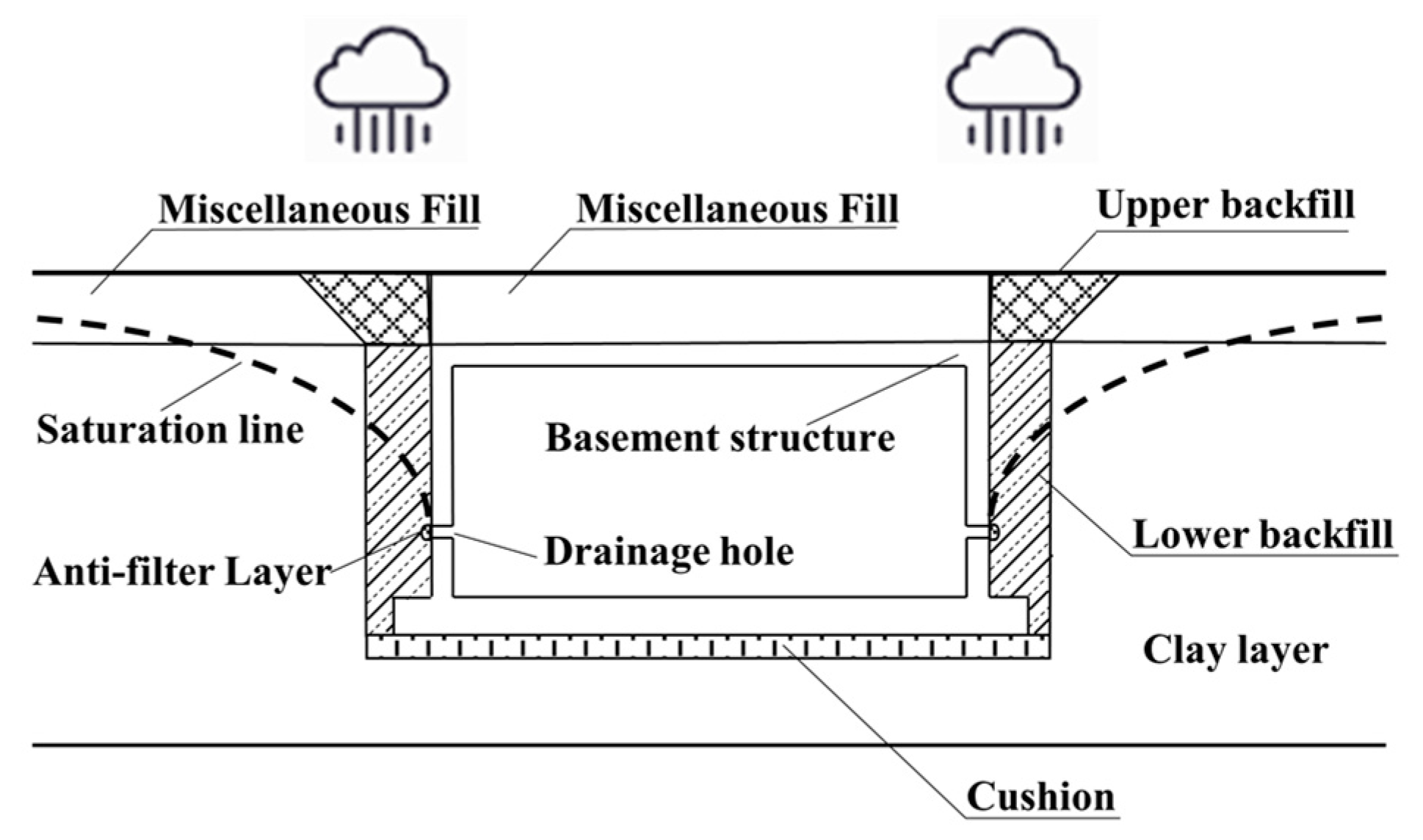

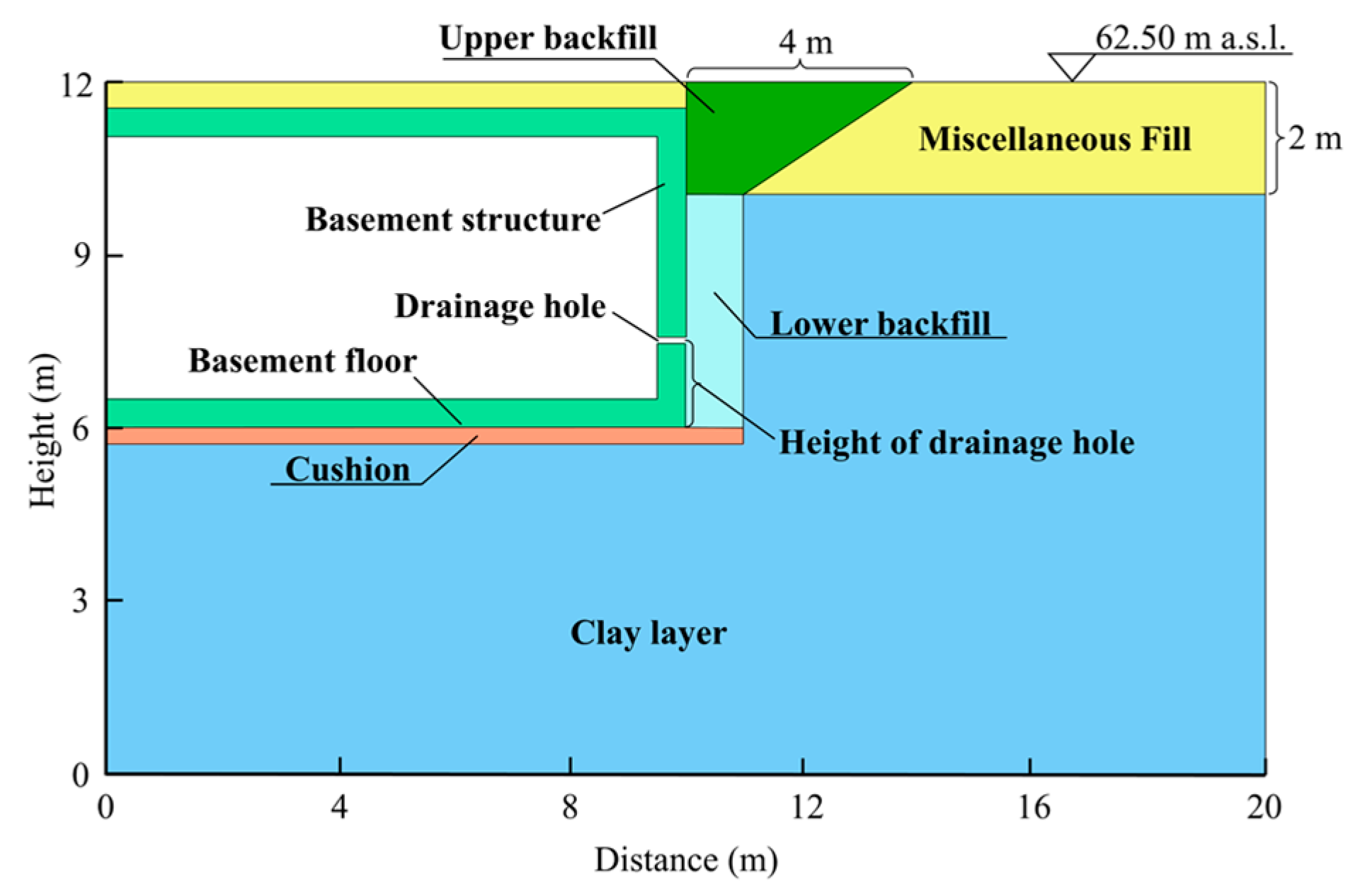

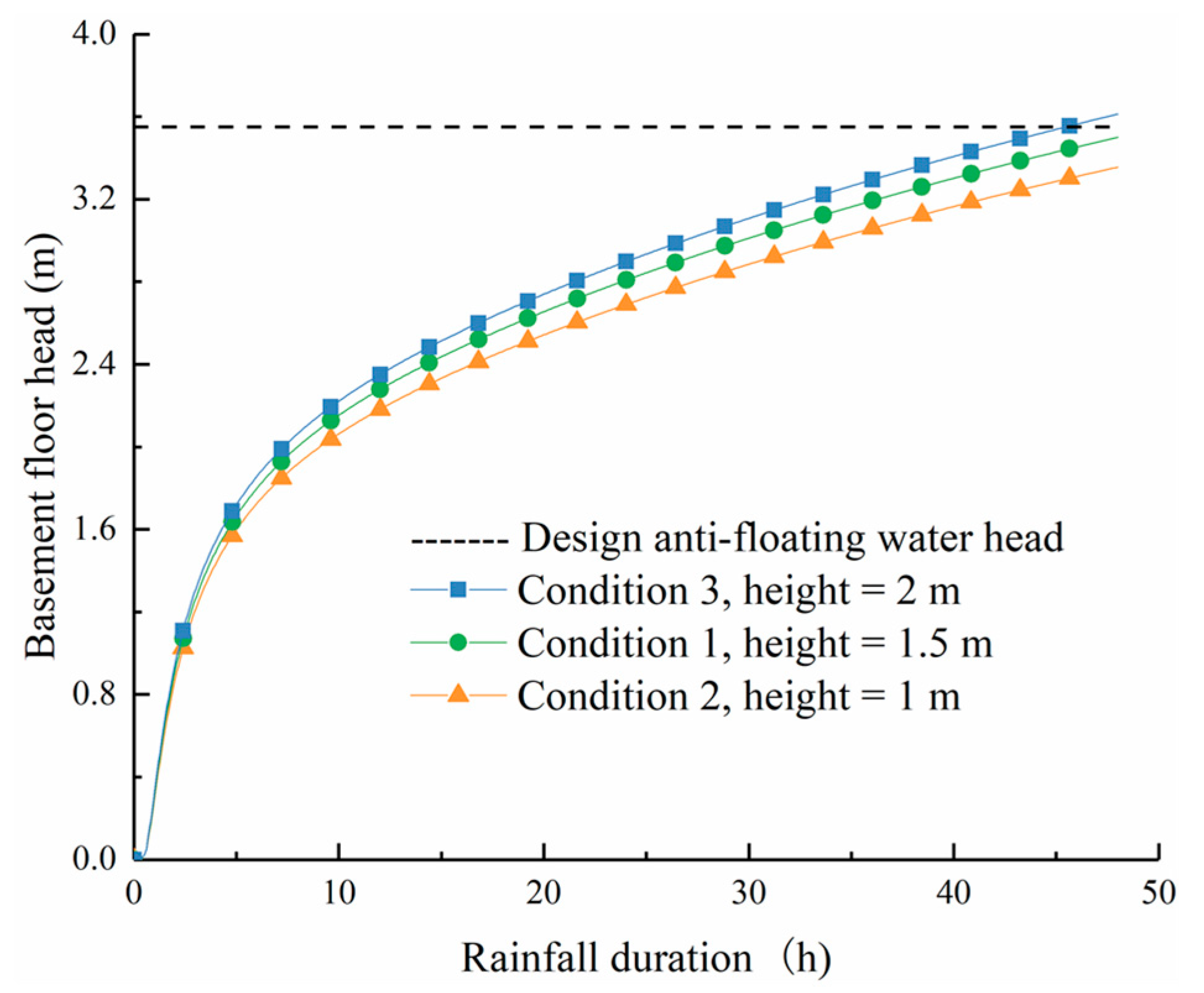
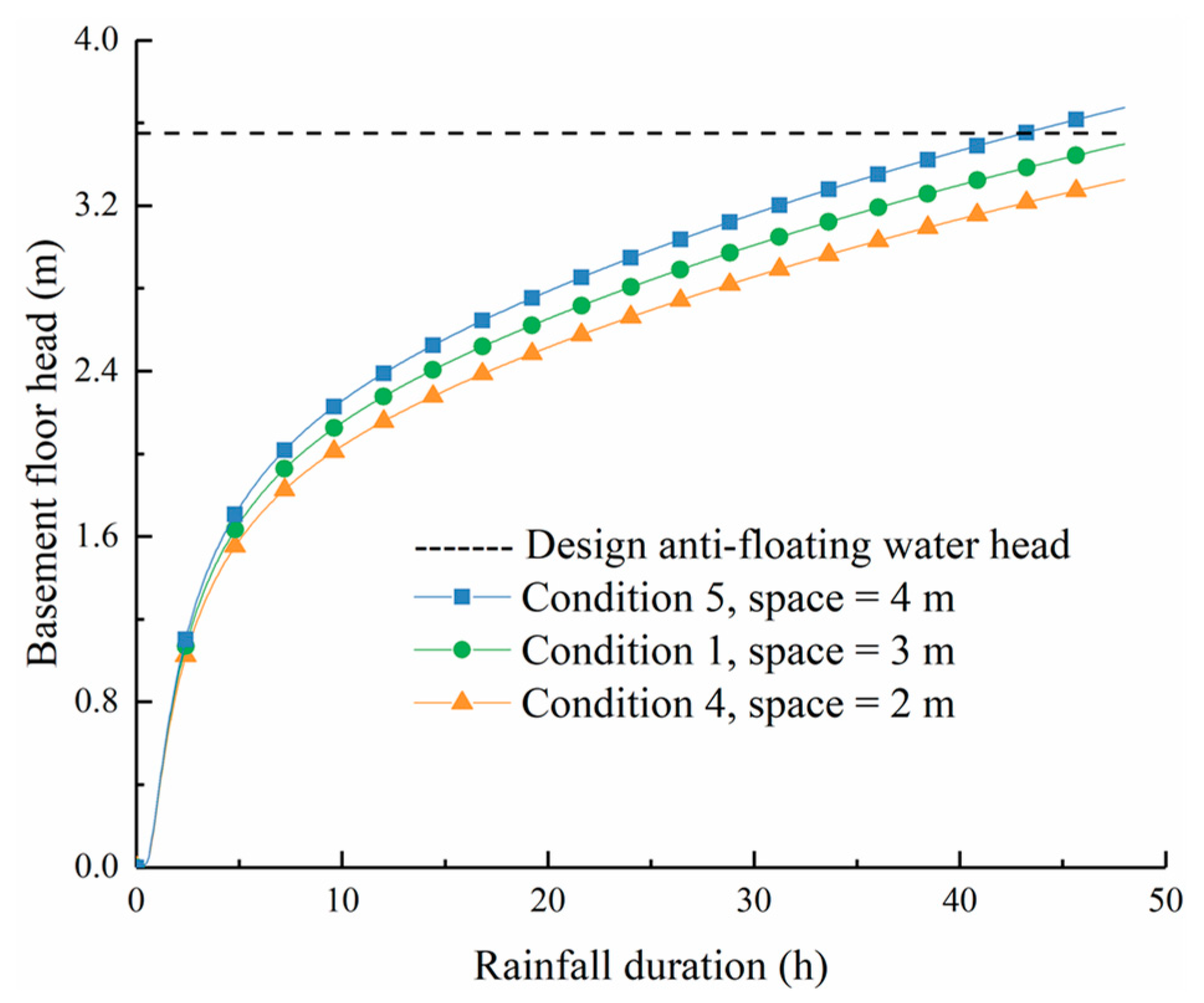
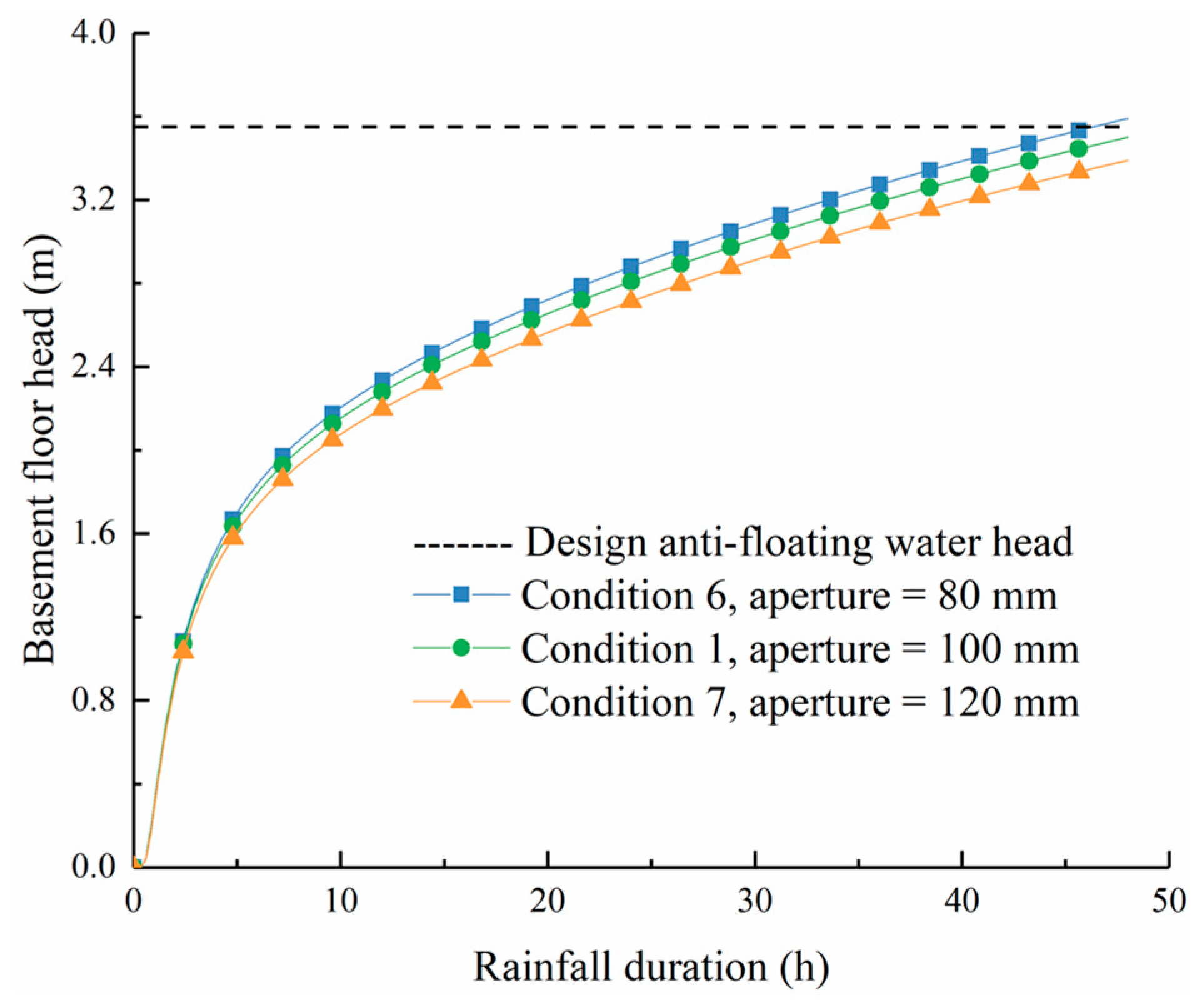

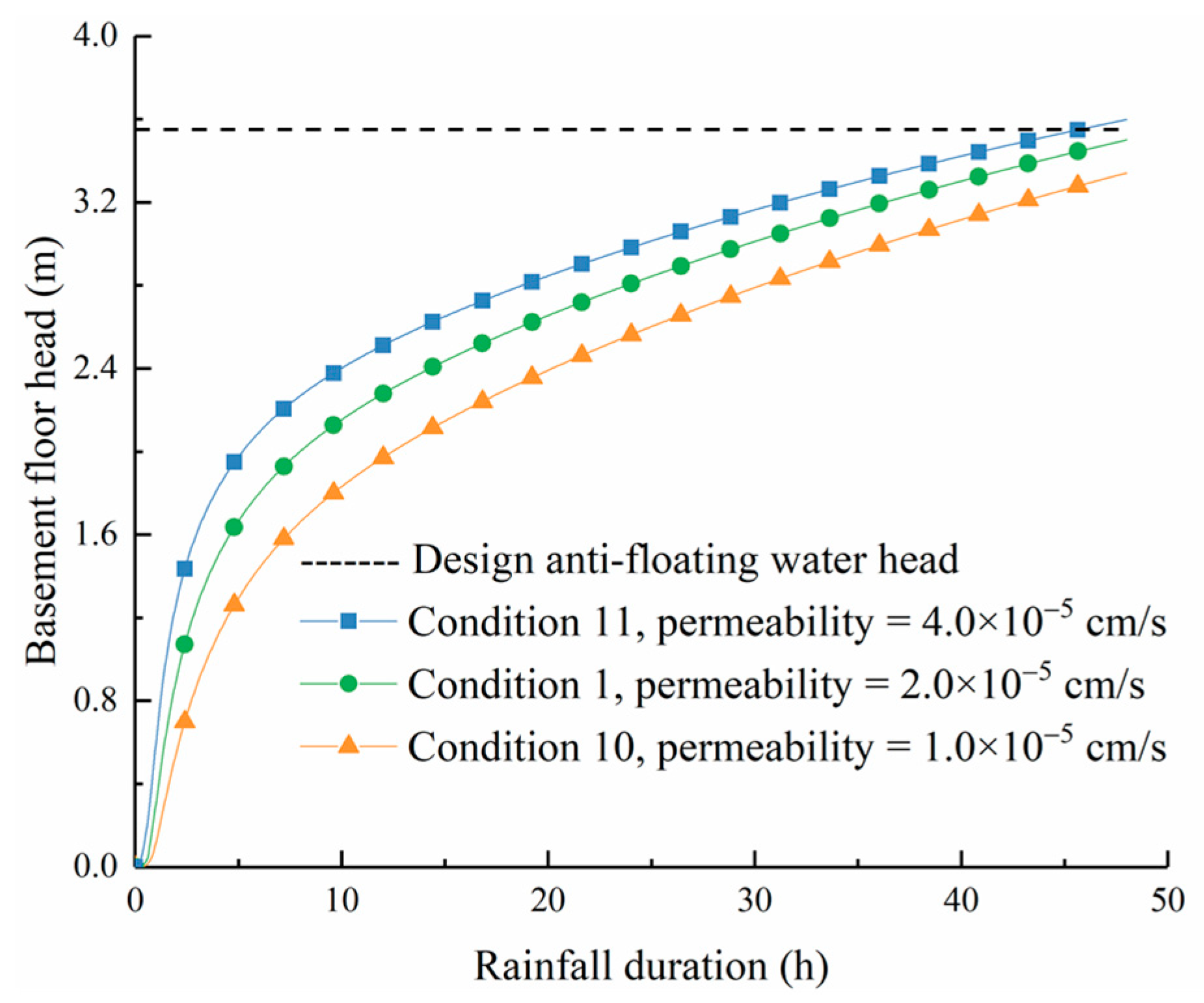

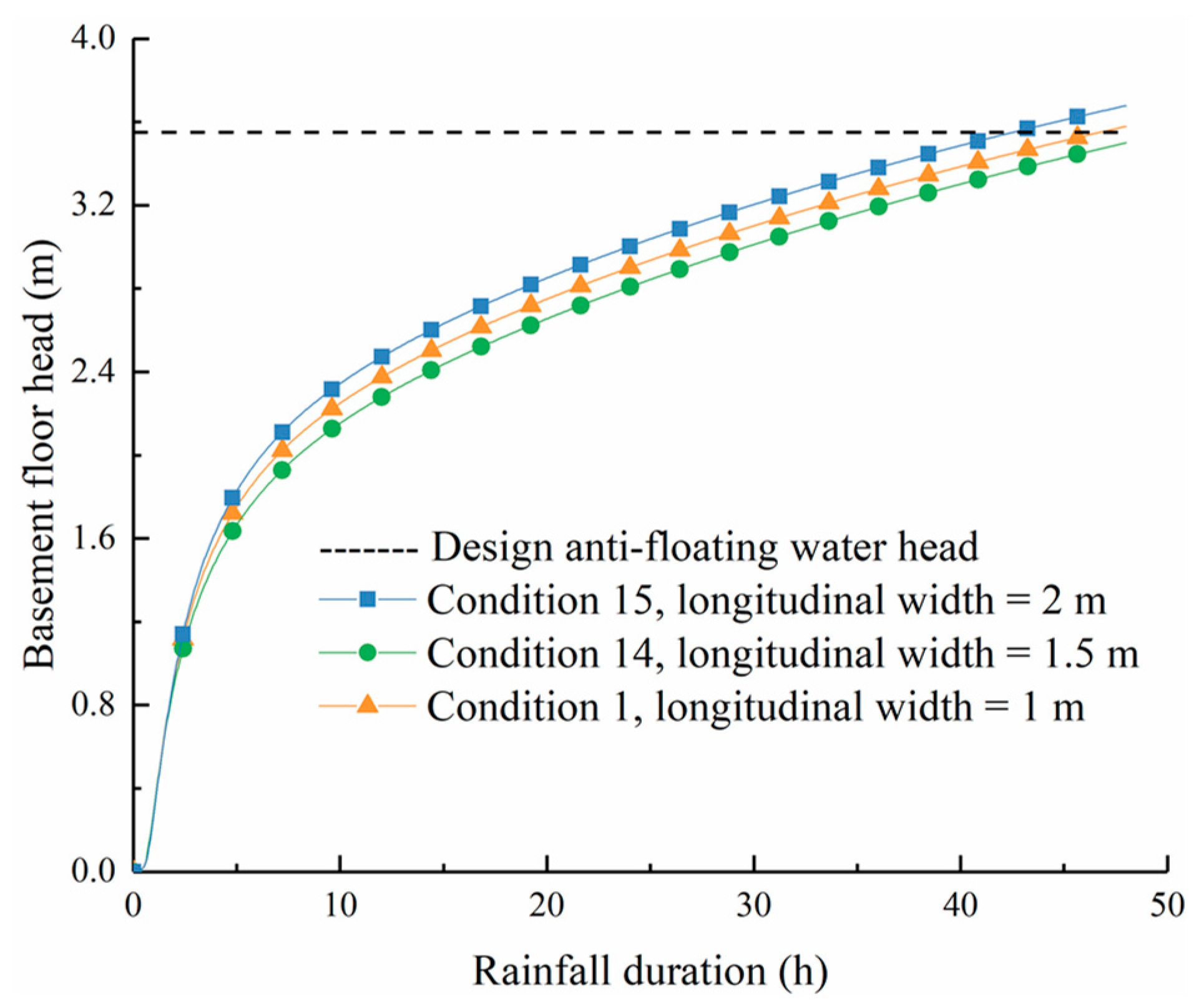
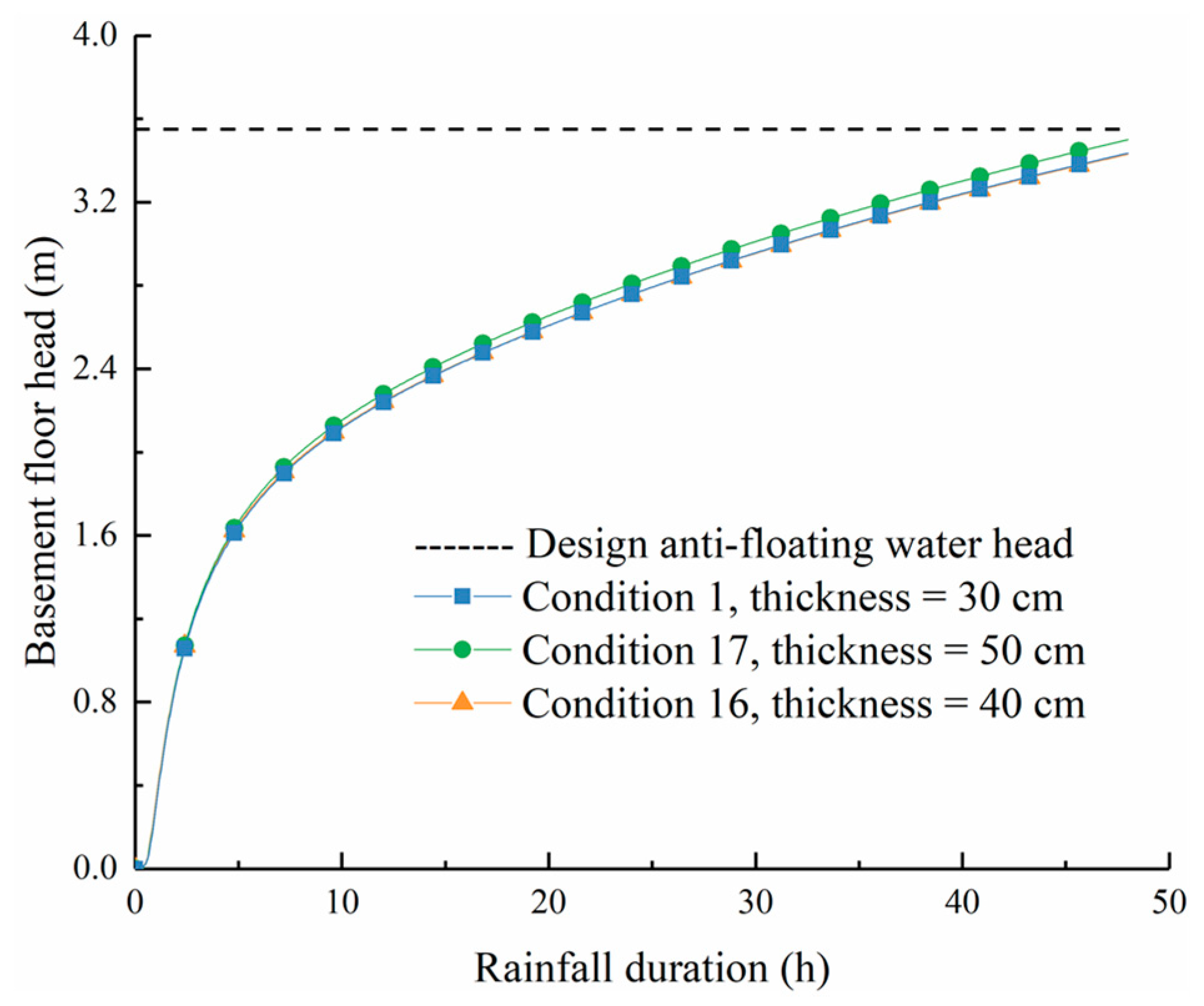
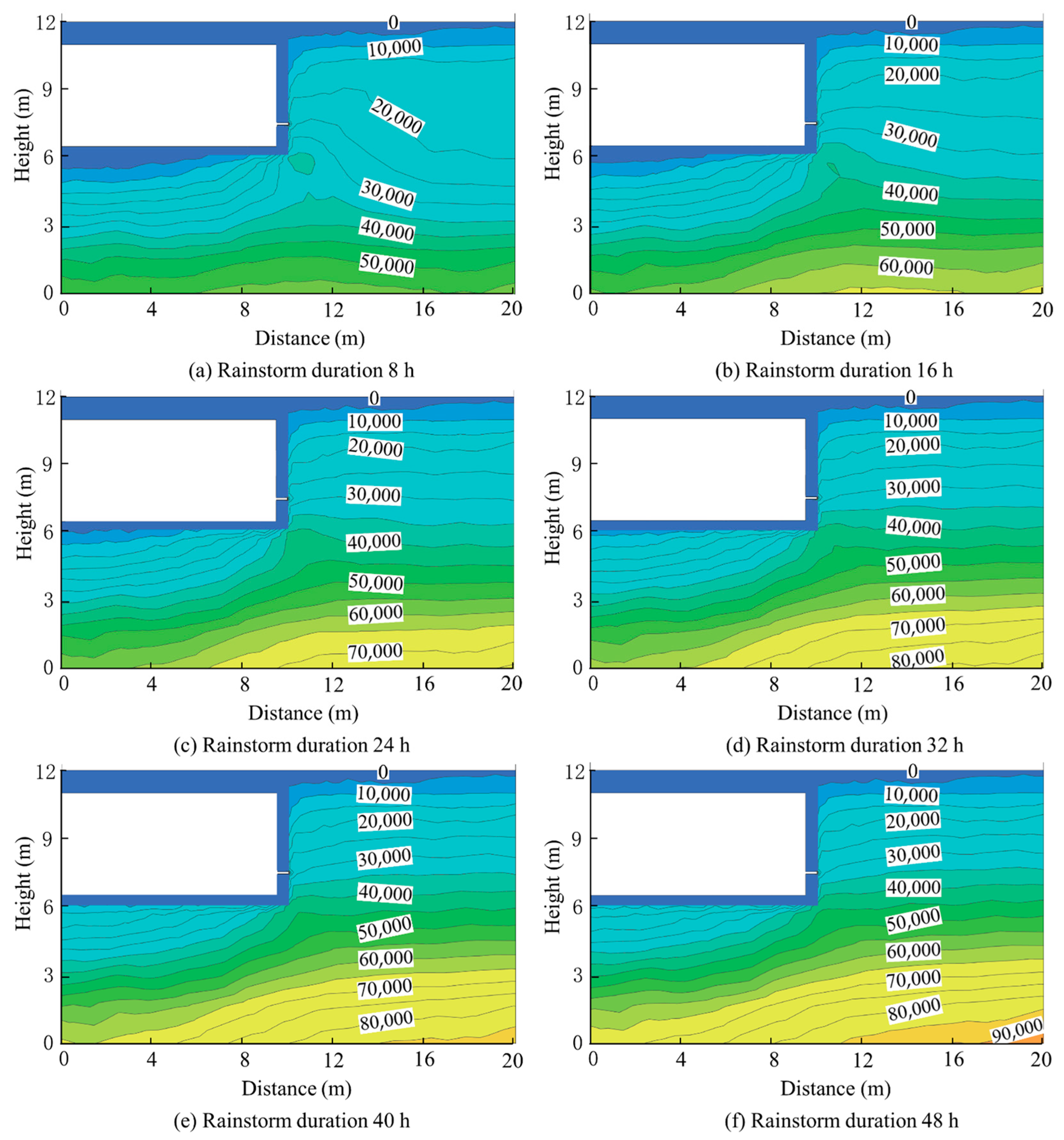
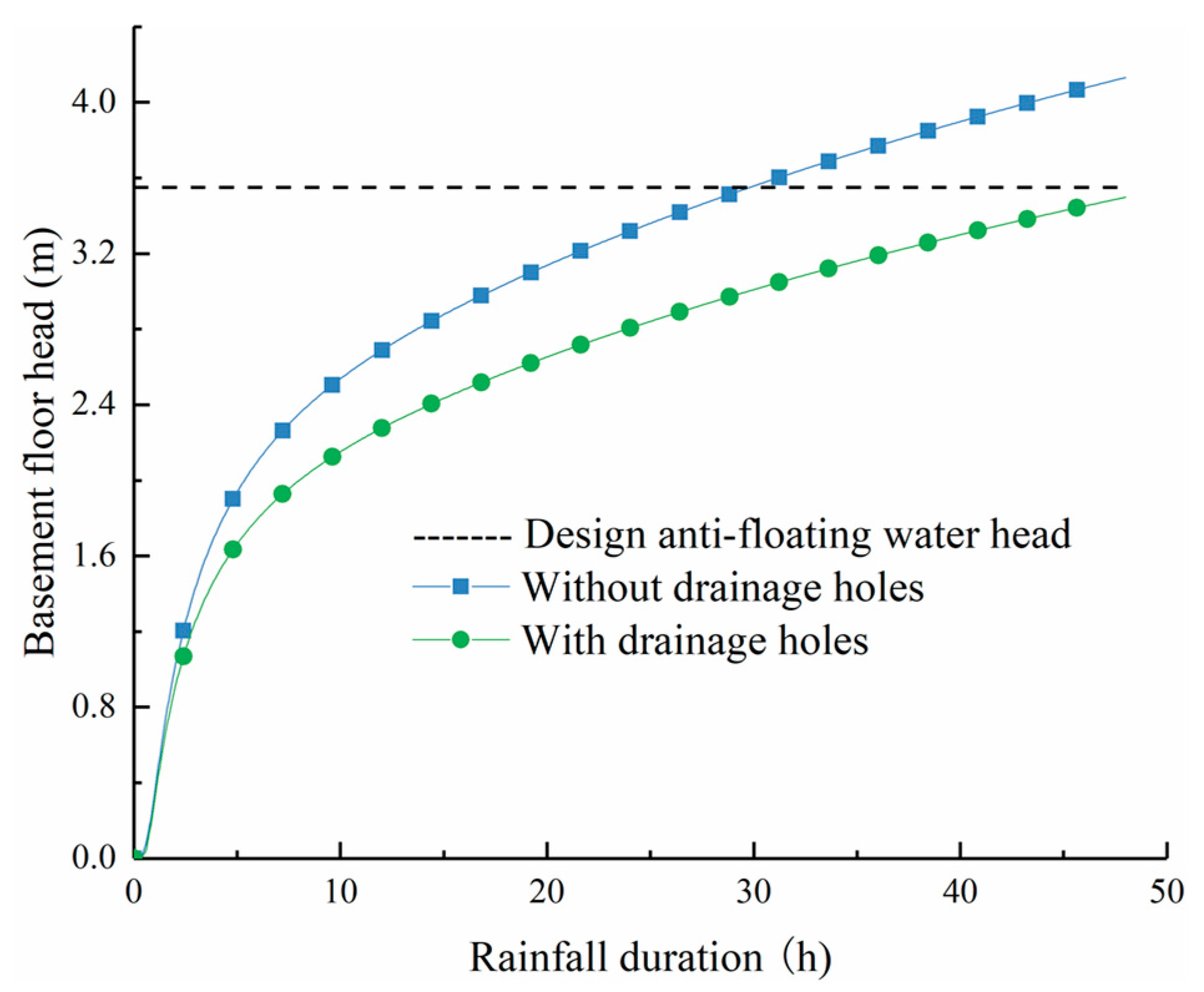
| Soil Layer | Soil Type | Soil Thickness (m) | Unit Weight (kN/m3) | Elastic Modulus (MPa) | Internal Friction Angle (°) | Cohesion (kPa) | Saturated Permeability Coefficient (cm/s) | Poisson’s Ratio |
|---|---|---|---|---|---|---|---|---|
| Miscellaneous Fill | Sandy soil | 2 | 18.4 | 5.2 | 8 | 8 | 2.0 × 10−4 | 0.2 |
| Upper backfill | clay | 2 | 18.5 | 6.3 | 8 | 8.5 | 2.0 × 10−6 | 0.21 |
| Lower backfill | Sandy soil and clay | 4 | 18.5 | 6.5 | 8 | 8.5 | 2.0 × 10−5 | 0.21 |
| Cushion | Clay | 0.3 | 18.6 | 8.0 | 16 | 9 | 2.0 × 10−6 | 0.25 |
| Clay layer | Clay | 10 | 18.3 | 26.0 | 16 | 25 | 1.0 × 10−6 | 0.25 |
| Condition Number | Influence Factor | |||
|---|---|---|---|---|
| Height of Drainage Hole (m) | Spacing of Drainage Hole (m) | Aperture of Drainage Hole (mm) | Maximum Head of Basement Floor after 48 h (m) | |
| 1 | 1.5 | 3 | 100 | 3.50 |
| 2 | 1 | 3 | 100 | 3.35 |
| 3 | 2 | 3 | 100 | 3.61 |
| 4 | 1.5 | 2 | 100 | 3.32 |
| 5 | 1.5 | 4 | 100 | 3.67 |
| 6 | 1.5 | 3 | 80 | 3.59 |
| 7 | 1.5 | 3 | 120 | 3.39 |
| Condition Number | Permeability Coefficient of Upper Backfill (cm/s) | Permeability Coefficient of Lower Backfill (cm/s) | Permeability Coefficient of Cushion (cm/s) | Permeability Coefficient of Clay Layer (cm/s) | Longitudinal Width of Lower Backfill (m) | Cushion Thickness (cm) | Maximum Head of Basement Floor after 48 h (m) |
|---|---|---|---|---|---|---|---|
| 1 | 2.0 × 10−6 | 2.0 × 10−5 | 2.0 × 10−6 | 1.0 × 10−6 | 1.0 | 30 | 3.50 |
| 8 | 1.0 × 10−6 | 2.0 × 10−5 | 2.0 × 10−6 | 1.0 × 10−6 | 1.0 | 30 | 3.48 |
| 9 | 4.0 × 10−6 | 2.0 × 10−5 | 2.0 × 10−6 | 1.0 × 10−6 | 1.0 | 30 | 3.52 |
| 10 | 2.0 × 10−6 | 1.0 × 10−5 | 2.0 × 10−6 | 1.0 × 10−6 | 1.0 | 30 | 3.39 |
| 11 | 2.0 × 10−6 | 4.0 × 10−5 | 2.0 × 10−6 | 1.0 × 10−6 | 1.0 | 30 | 3.59 |
| 12 | 2.0 × 10−6 | 2.0 × 10−5 | 1.0 × 10−6 | 1.0 × 10−6 | 1.0 | 30 | 3.34 |
| 13 | 2.0 × 10−6 | 2.0 × 10−5 | 4.0 × 10−6 | 1.0 × 10−6 | 1.0 | 30 | 3.63 |
| 14 | 2.0 × 10−6 | 2.0 × 10−5 | 2.0 × 10−6 | 1.0 × 10−6 | 1.5 | 30 | 3.58 |
| 15 | 2.0 × 10−6 | 2.0 × 10−5 | 2.0 × 10−6 | 1.0 × 10−6 | 2.0 | 30 | 3.68 |
| 16 | 2.0 × 10−6 | 2.0 × 10−5 | 2.0 × 10−6 | 1.0 × 10−6 | 1.0 | 40 | 3.43 |
| 17 | 2.0 × 10−6 | 2.0 × 10−5 | 2.0 × 10−6 | 1.0 × 10−6 | 1.0 | 50 | 3.42 |
Disclaimer/Publisher’s Note: The statements, opinions and data contained in all publications are solely those of the individual author(s) and contributor(s) and not of MDPI and/or the editor(s). MDPI and/or the editor(s) disclaim responsibility for any injury to people or property resulting from any ideas, methods, instructions or products referred to in the content. |
© 2023 by the authors. Licensee MDPI, Basel, Switzerland. This article is an open access article distributed under the terms and conditions of the Creative Commons Attribution (CC BY) license (https://creativecommons.org/licenses/by/4.0/).
Share and Cite
Chen, L.; Wang, W.; Bu, A. Numerical Simulation Study of Basement Water Discharge Pressure Relief Method under Rainstorm Conditions. Buildings 2023, 13, 2772. https://doi.org/10.3390/buildings13112772
Chen L, Wang W, Bu A. Numerical Simulation Study of Basement Water Discharge Pressure Relief Method under Rainstorm Conditions. Buildings. 2023; 13(11):2772. https://doi.org/10.3390/buildings13112772
Chicago/Turabian StyleChen, Longfeng, Weihua Wang, and Anhui Bu. 2023. "Numerical Simulation Study of Basement Water Discharge Pressure Relief Method under Rainstorm Conditions" Buildings 13, no. 11: 2772. https://doi.org/10.3390/buildings13112772
APA StyleChen, L., Wang, W., & Bu, A. (2023). Numerical Simulation Study of Basement Water Discharge Pressure Relief Method under Rainstorm Conditions. Buildings, 13(11), 2772. https://doi.org/10.3390/buildings13112772





